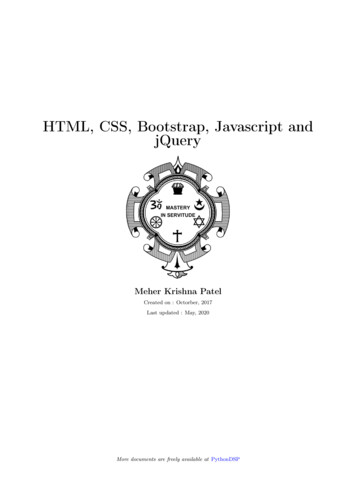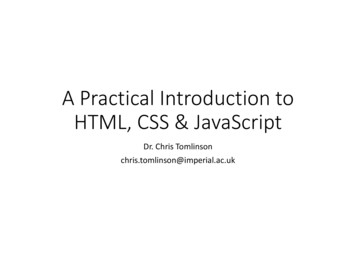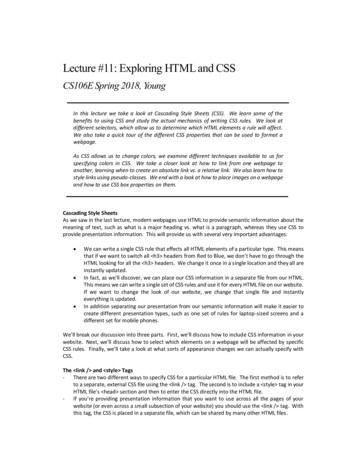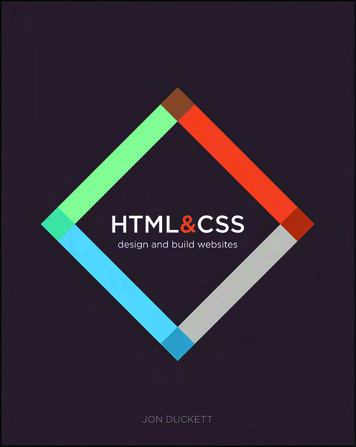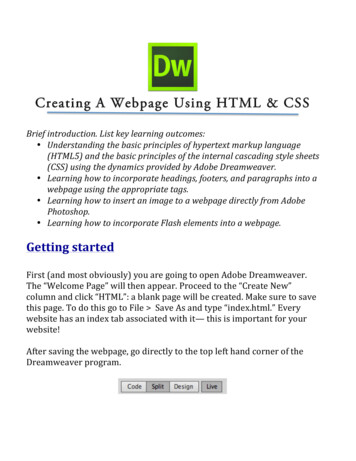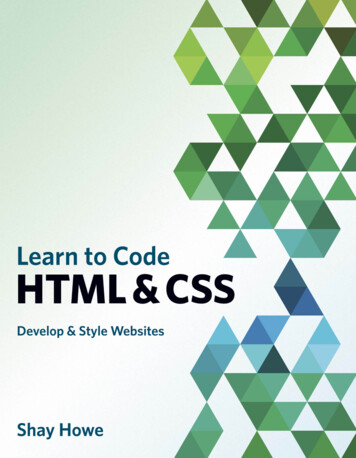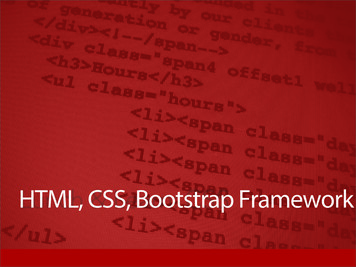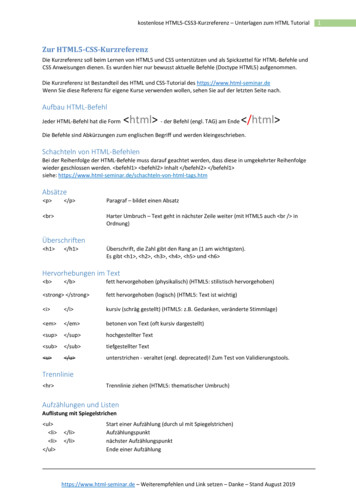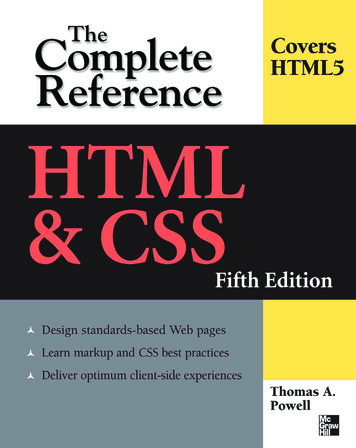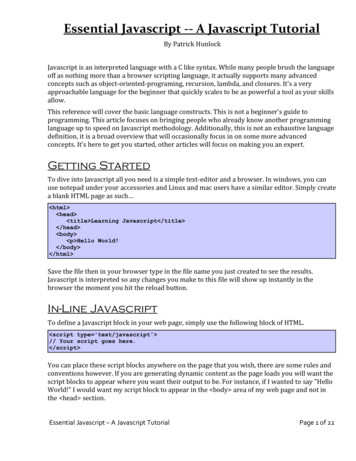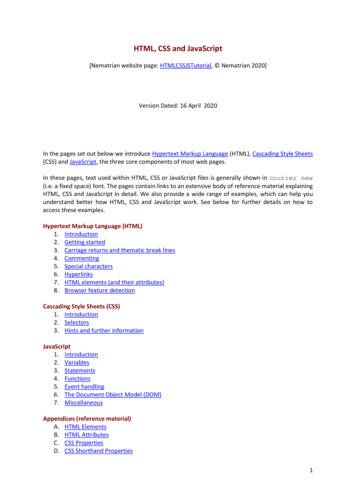
Transcription
HTML, CSS and JavaScript[Nematrian website page: HTMLCSSJSTutorial, Nematrian 2020]Version Dated: 16 April 2020In the pages set out below we introduce Hypertext Markup Language (HTML), Cascading Style Sheets(CSS) and JavaScript, the three core components of most web pages.In these pages, text used within HTML, CSS or JavaScript files is generally shown in courier new(i.e. a fixed space) font. The pages contain links to an extensive body of reference material explainingHTML, CSS and JavaScript in detail. We also provide a wide range of examples, which can help youunderstand better how HTML, CSS and JavaScript work. See below for further details on how toaccess these examples.Hypertext Markup Language (HTML)1. Introduction2. Getting started3. Carriage returns and thematic break lines4. Commenting5. Special characters6. Hyperlinks7. HTML elements (and their attributes)8. Browser feature detectionCascading Style Sheets (CSS)1. Introduction2. Selectors3. Hints and further informationJavaScript1. Introduction2. Variables3. Statements4. Functions5. Event handling6. The Document Object Model (DOM)7. MiscellaneousAppendices (reference material)A. HTML ElementsB. HTML AttributesC. CSS PropertiesD. CSS Shorthand Properties1
E.F.G.H.I.J.K.L.M.N.O.P.Q.R.S.T.U.V.W.X.Y.Z.CSS Animatable PropertiesCSS Keywords (inherit and initial)CSS Pseudo-Properties (content, counter-increment and counter-reset)CSS Rules (@font-face, @keyframes, @media)CSS SelectorsCSS Units: Times, Lengths, Angles and ColoursMiscellaneous CSS Property Values (Border Styles and Edge Multi-Value Formats)Default CSS Styles Applied to HTML ElementsHTML Special CharactersMarkup languagesJavaScript Statements: Reserved WordsJavaScript String VariablesJavaScript Regular ExpressionsJavaScript Numbers and Mathematical FunctionsJavaScript DatesJavaScript BooleansJavaScript ArraysJavaScript ObjectsJavaScript Error ObjectsJavaScript OperatorsThe JavaScript Document Object Model (DOM)Further JavaScript Properties and MethodsTo access HTML, CSS or JavaScript examples please go to the webpage on www.nematrian.comthat covers the specific feature you are seeking help with. More detailed examples (such as how todraw spinning3d shapes) are provided here.Disclaimer: Whilst we have made efforts to check the accuracy of the material in these pages, youshould note that HTML, CSS and JavaScript are evolving languages. Information contained in thisdocument may therefore be inaccurate or out-of-date. You should not rely on the accuracy orfitness for purpose of any material that you obtain from the Nematrian website (or from itsassociated web services). If you need these results to be accurate or fit for purpose then youshould seek independent corroboration of whatever you extract from the Nematrian website.Whilst using the site, users may be directed to the websites of other organisations, over whichNematrian may have no control and for which it takes no responsibility. A copy of the currentNematrian Web Services License Agreement can be viewed here.2
HTML Tutorial1. Introduction[HTMLTutorialIntroduction]Hypertext Markup Language (HTML) is one of the three main components of modern webpages,along with Cascading Style Sheets (CSS) and JavaScript. HTML indicates to the browser whatelements should be included in the webpage (and in what order). CSS indicates how each elementshould be styled. JavaScript provides a means for webpage authors to manipulate these elementsprogrammatically and in response to actions by the end user. Tutorials and reference materialcovering all three components are available here.In these pages, we describe HTML further. Text used within HTML, CSS or JavaScript files is generallyshown in courier new (i.e. a fixed space) font. The pages contain links to an extensive body ofreference material explaining HTML, CSS and JavaScript in detail. We also provide a wide range ofexamples, which can help you understand better how HTML, CSS and JavaScript work. See below forfurther details on how to access these examples.The concept of a markup language is explained further here. A document written in a markuplanguage like HTML has parts that get rendered in the eventual output, but also parts that informthe rendering software how to interpret the remaining text. ‘Rendering’ here refers to the process oftransforming the text document containing the HTML text into e.g. its visual representation on ascreen.The markup used by HTML includes tags, like p /p , to demarcate different HTML elementswithin the same webpage. In this case the p tag opens the relevant element and the /p closesit. p elements are typically used to delimit paragraphs in HTML. HTML elements can be nestedwithin other elements. Most elements can also be qualified by a range of attributes. For example, ifwe want to make the text within a p element appear red we can ascribe it a CSS style, along thelines of p style "color:red;" .Over time HTML has been refined. At the time of writing the latest version is HTML 5. Some aspectsof earlier versions of HTML are no longer recognised in HTML 5 and some of these are noted whererelevant.Tutorial contents:1.2.3.4.5.6.7.8.Introduction (i.e. this page)Getting startedCarriage returns and thematic break linesCommentingSpecial charactersHyperlinksHTML elements (and their attributes)Browser feature detectionTo access HTML, CSS or JavaScript examples please go to the webpage on www.nematrian.comthat covers the specific feature you are seeking help with.Disclaimer: Whilst we have made efforts to check the accuracy of the material in these pages, youshould note that HTML, CSS and JavaScript are evolving languages. Information contained in this3
document may therefore be inaccurate or out-of-date. You should not rely on the accuracy orfitness for purpose of any material that you obtain from the Nematrian website (or from itsassociated web services). If you need these results to be accurate or fit for purpose then youshould seek independent corroboration of whatever you extract from the Nematrian website.Whilst using the site, users may be directed to the websites of other organisations, over whichNematrian may have no control and for which it takes no responsibility. A copy of the currentNematrian Web Services License Agreement can be viewed here.2. Getting started with HTML[HTMLTutorialGettingStarted]As explained in HTML and other markup languages, there are various ‘dialects’ of HTML. This meansthat some examples of HTML may be understood by some browsers but rejected by others. Thefollowing text, when put into a text editor and saved with a .htm file extension, will usuallysuccessfully render a web page that says “Hello World (using HTML)” if the file is viewed in MicrosoftEdge. Note that HTML largely ignores page breaks; if you want to include a page break in the textshown to the user then you need to add a br element (or a br / element if you are usingXHTML, which is a modern variant of HTML that involves a cross between classic HTML and XML). html body Hello World (using HTML) /body /html However, strictly speaking an HTML document is supposed to start with a document typedeclaration, along the lines of e.g. !DOCTYPE html and a header along the lines of e.g. head title Document title /title /head . So, a better way to create the page shownabove is as follows. We’ve added a comment into the document, using HTML comment tags.Comments are not displayed by the browser but can help to document the HTML source text. !DOCTYPE html html head title My Document /title /head !-- Only the text in the body will appear in the browser -- body Hello World (Using HTML) /body /html Often, the html element also includes a lang attribute, as this can be important for accessibilityapplications (such as screen readers) and for search engines. With the lang attribute, the first twoletters specify the language. If the language comes in various dialects then two more letters specifythe dialect, e.g.:4
html lang "en-US" 3. Carriage returns and thematic break lines[HTMLTutorialLineBreaks]HTML markup largely ignores carriage returns (i.e. line breaks) within marked up files. Instead, if youwant to insert a carriage return you need to insert a br tag.By ‘largely ignores’ we mean that browsers do not render carriage returns as line breaks as such(except if certain styles apply to the element within which they appear, see e.g. the defaultformatting of the pre element). However, carriage returns do affect how HTML handles spaces atthe end of the line and at the start of the following line. Leading spaces (i.e. ones on a line beforeany non-space characters) are typically ignored, as are trailing spaces (i.e. ones on a line after thelast non-space character). However, browsers typically insert a 'breaking space' at the end of eachline, which often then shows up as a single space. Multiple spaces one after the other areinterpreted as a single space. To include more than one space in such instances you need to includea ‘non-breaking space’ as a special character, see here.For example the following markup:Hello (followed by two carriage returns) br br / Helloagainand againcreates the following output:Hello (followed by two carriage returns)Hello again and againWebpage authors typically put a lot of effort into creating visually appealing material. One way ofbreaking up text is to insert a thematic break line or horizontal rule, i.e. a hr tag, which places aline across the window like:4. Commenting[HTMLTutorialCommenting]It can be helpful to include comments in HTML documents that are not displayed but help readers ofthe underlying markup text you to understand what the HTML is trying to do. Comments in HTMLtake the form !-- comment -- and ignore line breaks within the opening and closing tags ofthe comment element.For example, markup as follows: !-- material explaining how commenting in HTML5
works-- creates the following output (i.e. nothing):5. Special characters[HTMLTutorialSpecialCharacters]The underlying markup of a webpage typically contains many more ampersand characters (i.e. &)than appear in the rendered output. This is because the & character is part of the way in whichHTML marks up 'special' characters, i.e. ones that would otherwise be understood by HTML to relateto markup. In HTML, each special character is preceded by an ampersand, followed by the HTMLmarkup name for that character followed by a semicolon. Perhaps the most common specialcharacters are:Special characterampersandspace (technically a ‘nonbreaking’ space)less than signgreater than signquotation markapostropheMeaning&(e.g. as in Hello again) "'HTML code& (e.g. as ;A fuller list of HTML special characters is available here.6. Hyperlinks[HTMLTutorialHyperlinks]Many people associate web pages with hyperlinks, i.e. the ability to navigate from one page toanother page. In HTML, hyperlinks (also called ‘anchors’) typically have the following sort ofstructure: a href "Pages/AboutNematrian.pdf"; text /a The text is what the user sees, the value of href is where the link points to. Points to note include:(a) The ‘text’ material seen by the user can contain HTML, so can include e.g. images andformatted text(b) The href value used here, i.e. “Pages/AboutNematrian.pdf” means that the linkpoints to a webpage (or other resource) called “AboutNematrian.pdf” in the directory“Pages” (strictly speaking a subdirectory of the directory in which the source webpageresides, unless it e.g. starts with http:// or https:// or unless the document’s base element, if any, defines a different base address to be used by relative uniform resourcelocators, i.e. ‘URLs’).The above link renders as:6
textGroups of hyperlinks can be included in a nav element. For example, markup as follows: nav a href "Introduction.aspx" Introduction /a a href "IntroductionSoftware.aspx" Software /a /nav creates the following output, involving 2 individual hyperlinks:Introduction Software7. HTML elements and their attributes[HTMLTutorialHTMLElements]The basic building blocks of HTML are elements (also called tags). A list of recognised elements isshown here. Some HTML elements, like the hyperlinks in HTMLTutorialHyperlinks, are by defaultdifferentiated from the text around them. The most general way of formatting text (capable ofaltering any of the default formatting of any visible HTML element) involves use of Cascading StyleSheets (CSS) or in-file or in-line equivalents, see Nematrian's CSS Tutorial. In-line CSS involvesassigning a specific style attribute to a given element. Other sorts of attributes can also be assignedto different sorts of elements. A list of recognised attributes is shown here. The exact range ofattributes valid for a specific element type does vary; see individual elements or attributes forfurther details.Many other elements are also by default differentiated from the text around them or exist primarilyto facilitate this sort of differentiation. Examples include:HTML elementNormally used for e.g.example address Contact information for the author or owner of adocumentMr. Smith, 1, GeorgeStreet, Georgetown b Bold text1, George Street,Georgetown blockquote Section that is quoted from another source1, George Street,Georgetown cite Title of a workSystemic Risk code A piece of computer codevar x 2.0; del Indicates text deleted from a documentabc dfn Defining instance of a termHTML, a markuplanguage em Emphasised text (often used to italicise text, butideally this should be done using CSS, as emphasisdoes not need to involve italics)HTML, a markuplanguage footer Footer for a document or sectionHTML7
Header 1Header 2 h1 , h2 , h3 , h4 , h5 , h6 HTML headingsHeader 3Header 4Header 5Header 6 header Header for a document or sectionHTML i A part of text in an alternate voice or moodHTML, a markuplanguage ins Indicates text added to a documentdef kbd Keyboard inputtext representingkeyboard input mark Marked/highlighted texttext to highlight pre Preformatted textpreformatted text(in fixed-widthfont that alsopreservesspaces andline breaks q Short quotationMary had a little lamb s Text that is no longer correctabc samp Sample output from a computer programoutput small Smaller text1, George Street,Georgetown strong Defines more important text, commonly used asanother way of highlighting text or making it boldMary had a littlelamb sub Subscripted textA1 summary Heading for a details elementHeading sup Superscripted textA1 time Date / time (N.B. isn't normally differentiated fromstandard text in most modern browsers)10:00 u Text that should be stylistically different from normalabctext, commonly used for underlining var Variable wbr Posible line-break, the Word Break Opportunity tagspecifies where in a text it would be ok to add a linebreakParam18
Some HTML elements are no longer supported in HTML5. Although they often work in browsers youshould ideally use CSS instead. These include:HTML elementNormally used for e.g.example big Big text1, George Street,Georgetown center Centred textabc font as in e.g. fontcolor "green" Green textgreen text strike Strikethrough text, not supported inHTML 5 (instead use del or s )abc tt Teletype textabcSome HTML tags differentiate content, but primarily to assist the browser's understanding of thatcontent, e.g.:HTML elementNormally used for e.g.example abbr as in e.g. abbrtitle "Mister" Abbreviation or acronymMr. data as in e.g. datavalue "1011" Links content with a machine-readable translationAppleSome HTML tags demarcate content so that the material can be segmented up more effectively, orassigned different formatting styles, e.g.:HTML elementNormally used for e.g.example article ArticleTitle aside Content aside from the page content details Additional details that a user can view or hide div Section in a documenta single piece ofcontent main Main content of a documentmain text p Paragraph (by default has space added above and belowthe text)a paragraph section Section in a documenta section span Section in a documenta section (span)MaterialTitleMaterialTitleMaterialA summary of the default styles applied to each HTML element is set out here.9
8. Browser feature detection[HTMLTutorialFeatureDetection]Hypertext Markup Language (HTML), Cascading Style Sheets (CSS) and JavaScript form the mainelements of modern webpages. However, different browsers do not always interpret these webpagecomponents in entirely consistent ways.There are two main ways in which this occurs:(a) HTML, CSS and JavaScript are evolving through time, particularly as new ways of interactingwith webpages are developed. Most of their core components are understood by essentiallyall browsers. However, some newer features may only work on some browsers. Some maybe released in ‘beta’ or ‘test’ form, but may eventually be dropped in any finalised updates.(b) Webpages are nowadays accessed across a wide range of formats. These formats can takedifferent physical forms. Even when they involve a ‘traditional’ screen-based format, thescreens can come in many different sizes and resolutions (e.g. a PC-based screen is typicallylarger, and easier to resize, than a mobile phone-based screen). This makes it desirable toalter the way in which material is displayed depending on the format involved.Historically, webpage developers solved this problem using ‘browser detection’. In this approach,the developer would include in the webpage (or on the server delivering the webpage to the user)some means of detecting which browser was being used to access the webpage. This had two mainweaknesses. First, there are now many different browser providers most of whom also have manyversions of their browsers available. This made it very difficult for developers to keep up with thechanging browser scene. Second, a ‘browser detection’ approach fails to address (b) above. Thesame browser can run on multiple devices; if the devices themselves have different characteristicsthen these won’t be captured merely by identifying the browser being used.Nowadays, the trend is to use ‘feature detection’. In this approach, the developer includes elementsor other components in the webpage that identify if the browser and device being used to accessthe webpage supports a specific feature. The output is then optimised bearing in mind whether thefeature is available.Sometimes this type of functionality is explicitly built into HTML. For example, the media file formatsrecognised by HTML audio and video elements vary by browser. These HTML elementsspecifically allow developers to refer to more than one media source, depending on the formatinvolved. The browser being used can then select whichever source it recognises. If it doesn’trecognise any (or if it is not new enough to recognise audio or video elements), fallback text willbe displayed. The CSS @media rule can also be used in a way that allows the developer to alter thestyle used by an element to reflect the media in which the page is being viewed (e.g. the width orheight of the device).At other times, feature detection needs to be coded using JavaScript. The typical approach is toidentify whether a feature is supported by the browser and then to adjust output formattingaccordingly. However, it is not always easy to identify whether a specific feature is supported by thebrowser. Possible methods include:-Use the hasFeature method to determine whether the JavaScript Document ObjectModel (DOM) implementation supports the relevant featureSearch for DOM objects, properties or methods associated with the feature10
-Attempt to create an object that should have the feature and if creation is successful thentest whether it does support the featureUnfortunately, the hasFeature method is not well supported by several browsers and its use isoften not recommended. The Nematrian website includes functions for many JavaScript featuresthat can assist in checking whether the feature is being supported by the browser being used at thetime. See pages on individual features for further details.11
CSS Tutorial1. Introduction[CSSTutorialIntroduction]Cascading Style Sheets (CSS) is one of the three main components of modern webpages, along withHypertext Markup Language (HTML) and JavaScript. HTML indicates to the browser what elementsshould be included on the page (and in what order). CSS indicates how each should be styled.JavaScript provides a means for webpage authors to manipulate these elements programmaticallyand in response to actions by the end user. Tutorials and reference material covering all threecomponents are available here.In these pages, we describe CSS further. Text used within HTML, CSS or JavaScript files is generallyshown in courier new (i.e. a fixed space) font. The pages contain links to an extensive body ofreference material explaining HTML, CSS and JavaScript in detail. We also provide a wide range ofexamples, which can help you understand better how HTML, CSS and JavaScript work. See below forfurther details on how to access these examples.CSS instructions can be:(a) included within an individual HTML element (as part of the mark-up relating to thatelement), i.e. as ‘in-line’ CSS(b) included in the HTML file where the relevant element(s) are located, but not directly withinthe elements concerned, i.e. as ‘in-file’ CSS(c) included in external CSS files, i.e. as ‘external’ CSS, with a HTML link element used toindicate where any such CSS files applicable to a given HTML file are located.The style attributes of an HTML element can also be altered by JavaScript ‘on the fly’, e.g. after thepage has initially loaded or in response to specific user actions such as clicking a button.CSS styles typically operate according to a hierarchy, with any JavaScript overrides taking precedenceover any CSS styles present when the page is initially loaded but otherwise in-line CSS takingprecedence over in-file CSS and in-file CSS taking precedence over external CSS (unless the‘important’ characteristic is included in the style statement). In-file CSS is contained in a style element. If there is more than one such element then later ones take precedence over earlier ones.Older versions of HTML (e.g. HTML 4) require style elements to be in the head of the HTMLfile, although most browsers currently seem to accept them even if they appear in the body . Intheory, the latest HTML version at the time of writing (HTML 5) has the concept of a ‘scoped’attribute (e.g. style scoped ) which should allow you to apply different style elementsto different parts of the webpage (which could then legitimately appear in the body element),but not all browsers currently seem to cater for this aspect of HTML 5.External style sheets are referenced using a link element, which goes inside the head section.This type of link element has a form such as: link rel "stylesheet" type "text/css" href "mystyle.css" .External style sheets can be created in any text editor, should not contain any HTML tags (elements)and should be saved with a .css extension.12
In-file and external CSS are typically set out in the form of ‘rule-sets’. A rule set involves a selectorand a declaration block. The selector points to the type of HTML element to which the style applies,whilst the declaration block contains one or more style declarations separated by semicolons. Eachdeclaration involves a CSS property name, followed by a colon, followed by the value assigned to theproperty.For example, the style ruleh3 {color: blue; text-align: center;}has a selector which is h3 and a declaration block which is {color: blue; text-align:center;}. It tells the browser that any h3 element (to which the rule applies) should be centrealigned and appear in blue. As with HTML, line breaks and multiple spaces are ignored.Other types of selectors are introduced here and covered in more detail here.In-line CSS rule-sets involve the style attribute (and do not include a selector or the curly brackets /braces included in in-file or external CSS), e.g. they involve setting the element’s style attribute alongthe lines of: style "color: red";.Comments in CSS start with /* and end with */ and can span multiple lines.Over time CSS has been refined. At the time of writing the latest version is CSS3. Features in CSS1and CSS2 can typically still be used in CSS3.Tutorial content4. Introduction (i.e. this page)5. Selectors6. Hints and further informationTo access HTML, CSS or JavaScript examples please go to the webpage on www.nematrian.comthat covers the specific feature you are seeking help with.Disclaimer: Whilst we have made efforts to check the accuracy of the material in these pages, youshould note that HTML, CSS and JavaScript are evolving languages. Information contained in thisdocument may therefore be inaccurate or out-of-date. You should not rely on the accuracy orfitness for purpose of any material that you obtain from the Nematrian website (or from itsassociated web services). If you need these results to be accurate or fit for purpose then youshould seek independent corroboration of whatever you extract from the Nematrian website.Whilst using the site, users may be directed to the websites of other organisations, over whichNematrian may have no control and for which it takes no responsibility. A copy of the currentNematrian Web Services License Agreement can be viewed here.2. Selectors[CSSTutorialSelectors]CSS is typically set out in the form of ‘rule-sets’, which involve a selector and a declaration block.Usually CSS is applied to types of elements. For example, the style rule13
h3 {color: blue; text-align: center;}has a selector which is h3 and a declaration block which is {color: blue; text-align:center;}. It tells the browser that any h3 element (to which the rule applies) should be centrealigned and appear in blue. As with HTML, line breaks and multiple spaces are ignored.However, within HTML you can also define classes of elements with common formatting styles usingthe element’s class attribute. For example, the style rule.center {color: red; text-align: center}would indicate that any element with a class attribute equal to center should be centre-alignedand appear in red.You can also apply CSS to elements of a specific type and class. For example, the style ruleh3.center {color: green;}would indicate that h3 elements that have their class attribute equal to center should begreen.In-file CSS can also be applied to individual elements, if the id attribute of the HTML element hasbeen set (the id attribute should be unique within any given page). If you want to use this type ofCSS then precede the id value by a hash (#) character.For example, the style rule#para1 {color: yellow}would be applied to the HTML element with id equal to para1 (provided there is such an element)and it would appear yellow (unless overridden by a later style rule).You can also group together rules for elements with the same style definitions, separating eachselector with a comma. For example,h1 {color: red;}h2 {color: red;}h3 {color: red;}can be grouped together as follows to minimise code and make it easier to follow:h1, h2, h3 {color: red;}More general ways of identifying CSS selectors are set out here.3. Hints and further information[CSSTutorialHints]CSS Values14
In CSS, if you are using values that have units, e.g. applying values that are to be interpreted as CSSlengths (e.g. setting the size of an element’s left margin using e.g. margin-left: 20px) thenyou should not include a space between the value (here 20) and the unit (here px) as otherwise thestyle may be ignored.There are several ways of defining lengths in CSS. There are also specific conventions used whendefining CSS times, CSS angles and CSS colours.Hierarchy in CSS style rulesIf you have two or more style rules that would otherwise apply to a specific attribute of a specificelement then the hierarchy rules are that:--More specific rules override more general ones. Specificity is defined based on how manyIDs, classes and element names are involved as well as by whether there is an !importantdeclaration.When even these do not differentiate between styles then whichever one appears last is theone that is applied.For example, without the !important flag, h3 elements using the following styles wouldappear green (as the green style rule is after the red one), but with the !important flag it is thered one that applies in this instance:h3 {color: red !important}h3 {color: green}Setting the CSS style of the whole pageThe style of the whole page can be set by a style rule such as:body {background-color: lightblue;}Multi-valued CSS propertiesSome CSS properties take several values. For example, many HTML elements are deemed to have 4sides (top, right, bottom and left) and there are conventions on how to define properties thatencompass all four sides simultaneously, see here.More generally, some CSS properties are shorthand properties that set several other more granularproperties at the same time.Animation and other more sophisticated featuresCSS has developed over the years and it is now possible to create relatively sophisticated animationeffects using the CSS @keyframes rule, without needing to implement these animations usingJavaScript. It is also possible to apply different styles depending on the device being used to renderthe material, using the CSS @media rule. Material can be automatically added before or after HTMLelements using CSS ‘pseudo-properties’, such as the content pseudo-property.Styling of hyperlinksLinks can be styled differently depending on what state they are:15
Link al, unvisited linkLink that user has visitedLink when the user moves a mouse over itLink at the moment it is clickedAdvanced table formattingZebra-striped tables can
Text used within HTML, CSS or JavaScript files is generally shown in courier new (i.e. a fixed space) font. The pages contain links to an extensive body of reference material explaining HTML, CSS and JavaScript in detail. We also provide a wide range of examples, which can help you understand better how HTML, CSS
